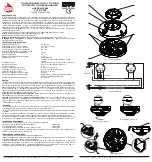
7.3 Notification Appliance Circuit Wiring Estimator
Use the chart (Figure 5) to determine the required wire size for each notification appliance circuit.
1) Compute the required current. (Number of appliances multiplied by appliance current = amperes)
2) Compute the distance in feet from panel to the last appliance.
3) Locate the total appliance load (amperes) on the vertical axis of the chart. Locate the wire length (feet)
on the horizontal axis of the chart. Find where they intersect.
4) Read the wire size in AWG on the curved line to the right of the point of intersection.
For wire lengths less than 100 feet, use 18 AWG minimum.
8.0 COMMON ALARM DRY CONTACTS
These contacts transfer and latch whenever the reversing relay is energized. Terminal 16 is common,
15 is normally open and 14 is normally closed. See Figure 6. Reversing relay K2 (P/N 4500-0024) must be
installed in the socket provided.
These contacts are rated 5 amps @ 26 VDC (resistive). Intended for connection to circuits powered from a
Listed power limited source of supply.
9.0 COMMON TROUBLE DRY CONTACTS
Whenever a System Trouble occurs, the trouble dry contacts will transfer. Terminal 20 is common, 21 is
normally open, and 22 is normally closed. See Figure 7. the contacts are rated 5 amps @ 26 VDC (resistive).
Trouble relay K1 (P/N 26592) must be installed in the socket provided. Intended for connection to circuits
powered from a Listed power limited source of supply.
Figure 5
16
COM
15
14
N/C
N/O
Figure 6 Common Alarm Dry contacts
22
RELAY K1 MUST BE INSTALLED
N/C
N/O
C
20
21
Figure 7 System Trouble Dry Contacts
Page 12 of 28
9000-0007
firealarmresources.com
Содержание FC-72 Series
Страница 2: ...firealarmresources com ...
Страница 31: ...firealarmresources com ...
Страница 32: ...301 2nd Ave Waltham MA 02451 1133 USA TEL 781 487 0088 FAX 781 370 4132 firealarmresources com ...










































